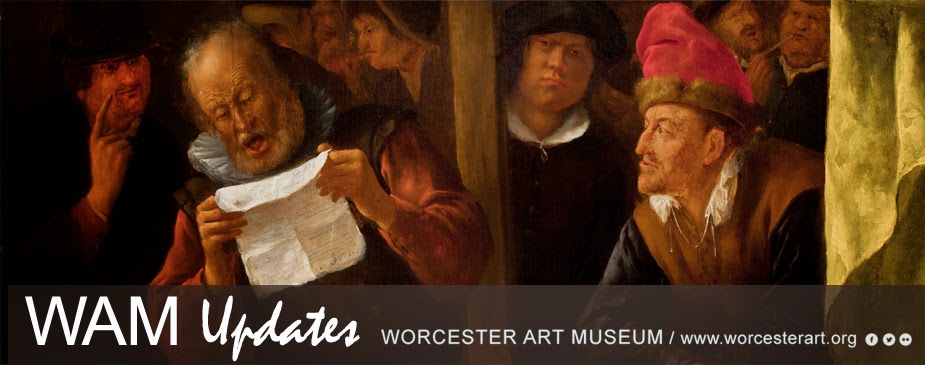The Higgins Education Wing will exhibit artwork created by young artists as a part of the Studio Art Program’s summer classes from August 12 – September 18. Our Summer Youth Student Exhibition presents over 200 works of art by young artists from 50 classes in the areas of painting, sculpture, illustration, mixed media, and printmaking. The exhibition features a wide range of visual practices, spanning many genres and media.
Our philosophy places value on the process of creating art and learning to think and respond creatively. We provide an environment where students can explore other cultures through our outstanding collection of artworks from antiquities to contemporary art. Students will have the opportunity to try new materials and gain self-confidence. All youth, not just those with perceived talents, benefit from working with art materials and learning about self-expression.
The exhibition, located in the Higgins Education Wing, is free and open to the public Sunday–Saturday, from 9am to 5pm. Register for a WAM Studio Art Class to be eligible for our next student exhibition! WAM’s fall session for adult starts September 11th and youth/teen classes start October 1st.
Click here for more information about faculty and their classes or to register today.
Image: Student Emma Roche
- Ashley Occhino, Manager of Studio Class Programs
Welcome to WAM Updates
WAM Updates are short, informal posts that put the spotlight on small, but exciting, Museum-related projects, such as the addition of a new painting or sculpture to a gallery. They also serve as updates on staff, new services or programs, and other WAM news.
We hope you like reading the Updates! If you are interested in learning about something specific, or have a suggestion for a WAM Update, please update us at wamupdates@worcesterart.org
Monday, August 15, 2016
Tuesday, August 9, 2016
Crouching Tiger Hidden Dragon
Be sure to stop by the Japanese art gallery for a last chance to see the Museum’s exquisite pair of Kano school tiger and dragon screens, which will go off view soon on August 22. Established in the 1400s and continuing into modern times, the distinguished Kano school of hereditary professional painters is the longest flourishing and influential school of painting in Japan. The Kano brothers, Kano Tan’yu and Kano Naonobu, were court painters to the shogun in Edo, or present-day Tokyo.
The two screens reflect the intimate relationship in Japan between the dragon and tiger, which are often depicted together. According to the ancient Chinese philosophy of Taoism that was influential in Japan, the dragon and tiger symbolize two opposite yet complementary forces (yin and yang) in the universe. While the tiger represents yin, or passivity, darkness, and the earth, the dragon represents yang, or activity, light, and the heavens.
Revealing great talent and connoisseurship of classic Chinese and Japanese ink paintings, Tan'yu depicted the dragon with fluid, confident brushwork and a great control of ink washes and tones. In contrast, Naonobu’s style was more restrained and quiet. He endowed the tiger with vitality through the play of broad and thin, light and dark, and wet and dry brushstrokes enhanced by light ink washes.
- Vivian Li, Assistant Curator, Asian Art
Images:
KANO Tan’yu (Japanese, 1602-1674) - Dragon
KANO Naonobu (Japanese, 1607-1650) - Tiger
1630–1640 Pair of six-panel folding screens; ink on paper
Overall 172.7 x 377.8 cm (68 x 148 3/4 in.)
Museum purchase, Harriet B. Bancroft Fund and partial gift of Robert H. Simmons, 1987.9, 1987.10
Monday, August 1, 2016
Hot off the presses: a book on museums and empathy
I’m excited to share with you the newly published book Fostering Empathy Through Museums, edited by Elif M. Gokcigdem and published by Rowman & Littlefield. I partnered with Jonathan Carfagno, Director of Learning and Audience Engagement, Grand Rapids Art Museum on museums, core values and the importance of empathy as a value. Our chapter looks at the role that core values, the ethics that governs your organization, can and should have in cultural organizations. By looking at many successful, audience focused organizations – primarily for-profit organizations – we were better able to identify the role and importance that values can and should play in each organization.
Here at the Worcester Art Museum, we have already begun applying these ideas, working to make sure that the Museum is both an intellectually stimulating and engaging place and also one that understands and respects the different needs of our visitors. This includes elements like the experience arriving at the Museum, where we now also have parking spaces for expecting mothers, all the way to the experience in the galleries, where new configurations of seating encourage visitors to relax, not rush.
- Adam R Rozan, Director of Audience Engagement
Subscribe to:
Posts (Atom)
Recent WAM Updates
-
1. What was the Silk Road? The Silk Road was not a single road at all, but a network of trade routes connecting China to trade partners ...
-
Islamic art covers a vast geographical and chronological spectrum, from Spain to Southeast Asia over 1400 years. Though, despite all the dif...
-
Many people believe that the representation of figures is forbidden in Islamic religion and culture, but this is false. The Qur’an, in fact,...
-
The Worcester Art Museum is home not only to European arms and armor, but also the arms of other cultural groups including Japanese armors. ...
-
Utagawa Hiroshige, Awa Province: the Naruto Whirlpools , 1855, woodblock print, ink and color on paper The Japanese artist Utagawa Hir...









